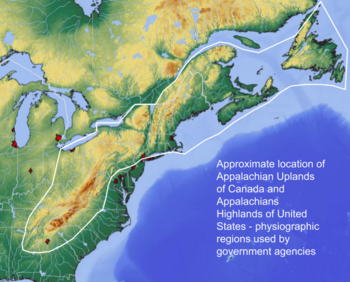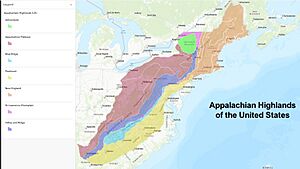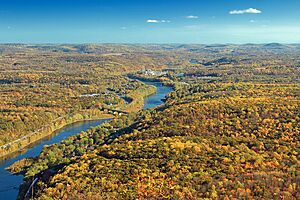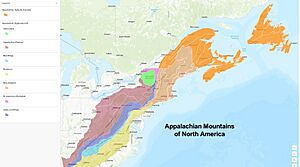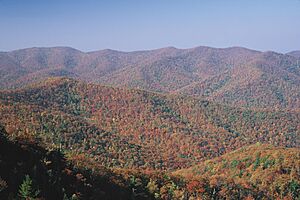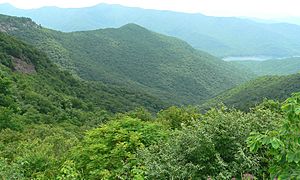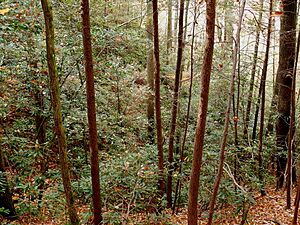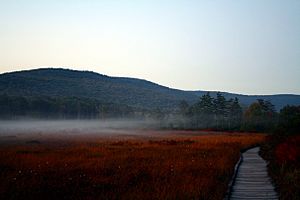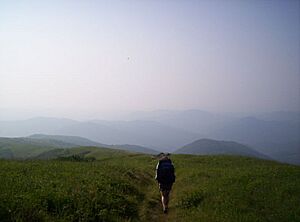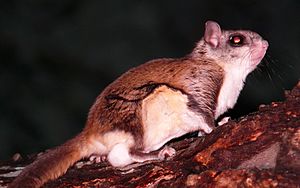Appalachian Mountains facts for kids
Quick facts for kids Appalachian Mountains |
|
|---|---|
| Appalachians | |
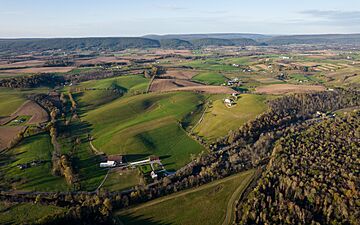
The Appalachian Mountains in the background with Penns Valley in Centre County, Pennsylvania in the foreground in October 2021
|
|
| Highest point | |
| Peak | Mount Mitchell in Yancey County, North Carolina, U.S. |
| Elevation | 6,684 ft (2,037 m) |
| Dimensions | |
| Length | 2,050 mi (3,300 km) |
| Geography | |
| Country |
|
| Geology | |
| Orogeny | Grenvillle, Taconic, Acadian, Alleghanian |
| Age of rock | Mesoproterozoic era (Stenian period)–Paleozoic era (Permian period); 1.2 billion years ago to 300 million years ago |
The Appalachian Mountains are a huge mountain range in eastern North America. When people say "Appalachian," they often mean the mountains and the land around them.
The tallest mountain here is Mount Mitchell in North Carolina, standing at 6,684 feet (2,037 m). It's also the highest point in the United States east of the Mississippi River. These mountains are much older than the Rocky Mountains out west. Some rocks in the Appalachians are over a billion years old!
Contents
- Where are the Appalachian Mountains?
- How Tall are the Appalachian Mountains?
- How Old are the Appalachian Mountains?
- How Were the Appalachian Mountains Formed?
- Why are the Appalachian Mountains Important?
- The Appalachian Trail
- Where Did the Name Come From?
- How Do You Say "Appalachian"?
- Geography of the Appalachians
- Climate
- Geology: How the Appalachians Were Made
- What Resources are in the Appalachians?
- Rivers and Water Flow
- Plants of the Appalachians (Flora)
- Animals of the Appalachians (Fauna)
- See also
Where are the Appalachian Mountains?
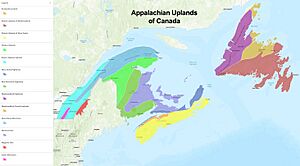

These mountains start way up in Newfoundland, Canada. They stretch all the way down to Alabama in the United States. That's about 2,050 miles (3,300 kilometers) long!
They even cross a tiny group of islands called Saint Pierre and Miquelon. These islands belong to France. So, the Appalachian Mountains are found in three countries: Canada, the United States, and France!
How Tall are the Appalachian Mountains?
The tallest mountain in the Appalachian range is Mount Mitchell. It is located in North Carolina. It's 6,684 feet (2,037 meters) high. That's like stacking about 668 school buses on top of each other! Mount Mitchell is also the highest point in the United States east of the Mississippi River.
How Old are the Appalachian Mountains?
The Appalachian Mountains are super old. They are much older than the Rocky Mountains in the western United States. Some of the rocks in the Appalachians were formed over a billion years ago! That's before dinosaurs even existed.
How Were the Appalachian Mountains Formed?
A long, long time ago, the Earth's continents were all squished together. When two big continents, Laurentia and Amazonia, bumped into each other, they created a super-big continent called Rodinia. This collision made the rocks fold and break, pushing up the first mountains in the area.
Over millions of years, other events made the mountains even bigger. They used to be as tall as the Alps or the Rockies. But wind and rain slowly wore them down over time.
Why are the Appalachian Mountains Important?
The Appalachian Mountains make it hard to travel from east to west. They are like a giant wall with lots of hills and valleys. This wall made it tricky for people to move west when the United States was first being settled.
The Appalachian Trail
The Appalachian Mountains are home to a very popular hiking path. It's called the Appalachian Trail. This trail is 2,175-mile (3,500 km) long.
It runs all the way from Mount Katahdin in Maine to Springer Mountain in Georgia. It passes over or near a large part of the Appalachian range. The International Appalachian Trail is an extension of this hiking trail. It goes into the Canadian part of the Appalachian range in New Brunswick and Quebec.
Where Did the Name Come From?
A long time ago, Spanish explorers were walking around Florida. They found a Native American village and wrote down its name as "Apalchen." The Spanish changed it to "Apalachee." They used it for the tribe and the area. Later, people started using the name for the mountains too.
How Do You Say "Appalachian"?
The name is pronounced locally as AP-ə-LATCH-ən. In northern parts of the mountain range, the third syllable is like "lay," and the fourth is "chins" or "shins." There is often a big debate among local residents about the correct pronunciation. Elsewhere, a common way to say the adjective Appalachian is with the last two syllables "-ian" pronounced like in the word "Romanian."
Geography of the Appalachians
Because the Appalachian Mountains are so big, it's hard to agree on exactly what they are. But the governments of the United States and Canada have special groups that study the land. These groups divide the land into regions to make maps.
In the United States, the Appalachian Mountains are part of a region called the Appalachian Highlands. In Canada, they are part of the Appalachian Uplands.
The Appalachian Highlands and Uplands are divided into smaller parts. In the United States, they are divided into provinces and sections. In Canada, they are divided into subsections.
- Northern: From Newfoundland to the Hudson River.
- Central: From the Hudson Valley to the New River.
- Southern: From the New River to Alabama.
The Appalachian Mountains have lots of valleys and ridges. The mountains don't all have the same height. Some are taller than others. But none of them are tall enough to have snow all year round. In Pennsylvania, there are over 60 mountains taller than 2,500 feet (800 meters). In West Virginia, there are over 150 mountains taller than 4,000 feet (1,200 meters).
| State or Province | Country | Physiographic Area | Highest Peak | Elev. (feet) | Elev. (meters) | Geographic Coordinates |
|---|---|---|---|---|---|---|
| Alabama | USA | Appalachian Plateau | Cheaha Mountain | 2,407 | 734 | 33.4869° N 85.8091° W |
| Georgia | USA | Blue Ridge | Brasstown Bald | 4,784 | 1,457 | 34.8745° N 83.8063° W |
| Kentucky | USA | Appalachian Plateau | Black Mountain | 4,145 | 1,263 | 36.9022° N 82.9144° W |
| Maine | USA | New England | Mount Katahdin | 5,269 | 1,606 | 45.9046° N 68.9216° W |
| Maryland | USA | Appalachian Plateau | Backbone Mountain | 3,360 | 1,024 | 39.4049° N 79.2911° W |
| Massachusetts | USA | New England | Mount Greylock | 3,489 | 1,063 | 42.3813° N 73.0957° W |
| New Brunswick | Canada | Chaleur Uplands | Mount Carleton | 2,690 | 820 | 47.2241° N 66.5233 ° W |
| Newfoundland | Canada | Newfoundland | The Cabox | 2,664 | 812 | 48.4959° N 58.2903° W |
| New Hampshire | USA | New England | Mount Washington | 6,288 | 1,917 | 44.1614° N 71.1811° W |
| New Jersey | USA | Valley and Ridge | High Point | 1,804 | 550 | 41.3206° N 74.6616° W |
| New York | USA | Adirondacks | Mount Marcy | 5,344 | 1,629 | 44.1126° N 73.9235° W |
| North Carolina | USA | Blue Ridge | Mount Mitchell | 6,684 | 2,037 | 35.7658° N 82.2655° W |
| Nova Scotia | Canada | Nova Scotia Highlands | White Hill | 1,755 | 535 | 46.7555° N 60.6350° W |
| Ohio | USA | Appalachian Plateau | Campbell Hill | 1,549 | 472 | 40.3888° N 83.6381° W |
| Pennsylvania | USA | Appalachian Plateau | Mount Davis | 3,213 | 979 | 39.7866° N 79.1751° W |
| Quebec | Canada | Notre Dame Mountains | Mont Jacques-Cartier | 4,160 | 1,268 | 48.9906° N 65.9425° W |
| South Carolina | USA | Blue Ridge | Sassafras Mountain | 3,553 | 1,083 | 35.0632° N 82.3062° W |
| Tennessee | USA | Blue Ridge | Kuwohi | 6,643 | 2,025 | 35.5625° N 83.4989° W |
| Vermont | USA | Green Mountains | Mount Mansfield | 4,395 | 1,340 | 44.5439° N 72.8143° W |
| Virginia | USA | Blue Ridge | Mount Rogers | 5,729 | 1,746 | 36.6586° N 81.5438° W |
| West Virginia | USA | Appalachian Plateau | Spruce Knob | 4,863 | 1,482 | 38.6992° N 79.5327° W |
St. Lawrence Valley
The St. Lawrence Valley is an area near the Appalachian Mountains. In the United States, it's part of the Appalachian Highlands. But in Canada, it's part of a different region called the St. Lawrence Lowlands.
Plateaus in the Appalachians
Some areas near the Appalachian Mountains are called plateaus. These are flat areas that are high up. People in Kentucky and West Virginia sometimes call these areas "mountains," even though they are more like high, flat lands.
Blue Ridge Mountains
The Blue Ridge Mountains are a famous part of the Appalachian Mountains. They start in Pennsylvania and get taller as they go south. The highest point in the Blue Ridge Mountains is Mount Rogers in Virginia. It is 5,729 feet (1,746 meters) high.
Climate
The Appalachians act as a long, mountainous spine running through the eastern United States, and their climate mirrors the regions they pass through, but with a cooler, wetter, and more extreme mountainous twist.
- Northern Appalachians (Maine, New Hampshire, New York): Humid Continental Climate. Characterized by cold, snowy winters and cool, humid summers.
- Central Appalachians (Pennsylvania, West Virginia, Virginia): A transition zone where continental influences begin to mix with milder southern air. Winters are cold, but less severe than the north, and summers are warm and humid.
- Southern Appalachians (North Carolina, Tennessee, Georgia): Humid Subtropical Climate in the lowlands, but the high elevations create a much cooler "highland" climate. Winters are milder, but the highest peaks (like Mt. Mitchell) can experience conditions similar to New England.
Seasonal Characteristics
Winter (December - February)
Cold and Snowy. Significant lake-effect snow falls on the western slopes in New York and Pennsylvania. The highest peaks in New England and the Southern Appalachians (above 5,000 feet) receive heavy snowfall, with some areas like Mount Washington, NH, experiencing arctic-like conditions.
Spring (March - May)
Unpredictable and variable. It arrives much later at higher elevations. This is a prime season for severe weather, including thunderstorms and tornadoes, in the central and southern parts of the range.
Summer (June - August)
Generally cool and moist. While lowland areas east of the mountains can be sweltering, the higher elevations of the Appalachians provide a cool refuge. Temperatures are typically in the 70s °F (low to mid-20s °C). It's the cloudiest season, with frequent fog and afternoon thunderstorms. The southern Appalachians are one of the rainiest regions in the eastern US during summer.
Fall (September - November)
Crisp and Dry. This is the most stable and celebrated season. Clear, sunny days and cool nights are ideal for the famous fall foliage. The vibrant colors are triggered by the combination of sunny days and cool (but not freezing) nights.
In summary, the climate of the Appalachian Mountains is a complex mosaic defined by its vertical landscape. It's a place where you can experience a Canadian-style winter, a refreshing summer escape, and a subtropical rainforest, all within the same mountain range.
Geology: How the Appalachians Were Made
The Appalachian Mountains were formed by the Earth's giant plates moving around. These plates crashed into each other and created mountains. Then, they pulled apart and created oceans.
The first time the plates crashed was over a billion years ago. This created a super-big continent called Rodinia. The mountains formed then are called the Blue Ridge Mountains and the Adirondacks.
After a while, Rodinia started to break up. The mountains that had been formed started to wear down. The pieces of rock that wore off formed valleys and basins.
About 500 million years ago, the plates started to move back together. This created more mountains. The Taconic orogeny built much of the land that is now New England and Pennsylvania.
Another big mountain-building event was the Acadian orogeny. This happened between 375 and 359 million years ago. It was caused by pieces of land from a continent called Gondwana crashing into the North American Plate.
About 270 million years ago, the continents that are now North America and Africa crashed into each other. This created a super-big continent called Pangea. The Appalachian Mountains were part of the same mountain chain as the Little Atlas in Morocco.
What Resources are in the Appalachians?
The Appalachian Mountains have lots of coal. There is also petroleum (oil) and natural gas. These are important energy resources.
Rivers and Water Flow
The rivers in the Appalachian Mountains flow in different directions. Some flow east to the Atlantic Ocean. Others flow west to the Mississippi River.
Plants of the Appalachians (Flora)
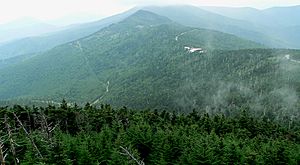
The plants in the Appalachians are very diverse. They change based on the type of rock, how far north or south they are, how high up they grow, and how much moisture there is.
The forests are mostly made of trees that lose their leaves in the fall (deciduous broad-leaf trees). There are also evergreen trees with needles (conifers). Some special trees include the American holly and the Tamarack larch.
At high elevations and in the north, you'll find red spruce trees. Another type of spruce, the black spruce, grows in bogs as far south as Pennsylvania.
Two kinds of fir trees grow here: the balsam fir and the Fraser fir. The Fraser fir only grows in the highest parts of the southern Appalachians. It forms a special ecosystem with red spruce.
Eastern or Canada hemlock trees also grow along the Appalachian chain. They prefer lower, moist areas. These trees are in danger from a tiny insect called the hemlock woolly adelgid.
Several types of pines are found in the Appalachians, like eastern white pine and pitch pine. These often grow in sandy, rocky, or poor soils.
The Appalachians are known for their many beautiful hardwood trees. The most diverse forests are "mixed-mesophytic" types. These are found in rich, moist soils in the southern and central Appalachians. Common trees include white basswood, yellow buckeye, sugar maple, and tuliptree.
Drier, rockier areas have oak–chestnut forests. These were once dominated by different kinds of oaks and the American chestnut. Sadly, the American chestnut was almost wiped out by a fungus called chestnut blight. Now, oaks have largely replaced them.
The Appalachian plant life also includes many mosses, liverworts, and fungi. Some of these are rare or found only here.
Forests in the Appalachians can be affected by insect outbreaks. The spongy moth eats oak leaves, which can harm trees. Another serious problem is beech bark disease, which affects beech trees.
In the past, there was a lot of logging and land clearing in the Appalachians. This led to the creation of national forests and parks to protect the area.
Some mountain tops in the southern Appalachians have open areas called Appalachian balds. These are either grassy meadows or areas with low, shrubby plants. They are home to many unique plants and animals. Scientists debate how these balds formed. Some think they were created by climate and grazing animals. Others believe people created them.
In the northern Appalachians, like the White Mountains, some summits have true alpine tundra. These areas are kept clear by harsh winter storms. They have plants similar to those found in the Arctic Circle.
Animals of the Appalachians (Fauna)
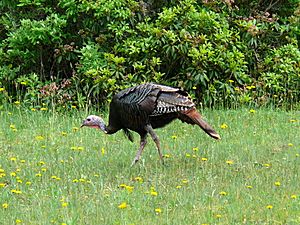
The animals that live in the Appalachian forests include five types of tree squirrels. The most common is the eastern gray squirrel. You might also see the larger fox squirrel or the tiny southern flying squirrel. In cooler, higher areas, there's the American red squirrel.
Other common forest animals are the eastern cottontail rabbit and the white-tailed deer. Deer numbers have grown a lot because their natural predators, like the eastern wolf and North American cougar, are mostly gone. This has led to deer eating too many plants in the forests.
Other deer include the eastern moose (only in the north) and the elk. Elk were once gone from the area but are now making a comeback. In Quebec, the Chic-Chocs mountains have the only population of reindeer south of the St. Lawrence River.
The North American beaver is also making a big comeback. Their dams and other structures are changing habitats throughout the mountains.
You might also see American black bears, striped skunks, raccoons, opossums, woodchucks, bobcats, gray foxes, red foxes, and coyotes. European boars were brought here in the early 1900s.
Common birds include wild turkeys, ruffed grouse, mourning doves, common ravens, and many types of hawks and owls. There are also many "songbirds," especially warblers.
The Appalachians are home to many salamanders, especially the lungless salamanders. They live hidden under leaves on the forest floor. You might also see the Eastern newt. Salamanders and other amphibians help the forest by eating small creatures.
While there are fewer reptiles than amphibians, some snakes are common. The non-venomous black rat snake is one of the largest. The common garter snake is smaller but very common. Two venomous snakes are the eastern copperhead and the timber rattler. The broad-headed skink is a large lizard. The eastern box turtle is found in both high and low forests. The large common snapping turtle lives in water throughout the Appalachians.
Appalachian streams are known for their many different kinds of freshwater fish. Minnows and colorful darters are very common. A special fish found in cool, shaded streams is the wild brook or speckled trout. It's a popular fish for anglers.
See also
 In Spanish: Apalaches para niños
In Spanish: Apalaches para niños
- Appalachia
- Appalachian American
- Appalachian League
- Appalachian Mountain Club
- Appalachian Trail
- List of subranges of the Appalachian Mountains


